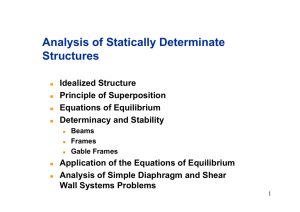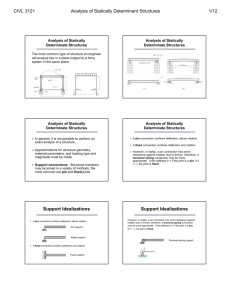Statics of Structural Supports
advertisement
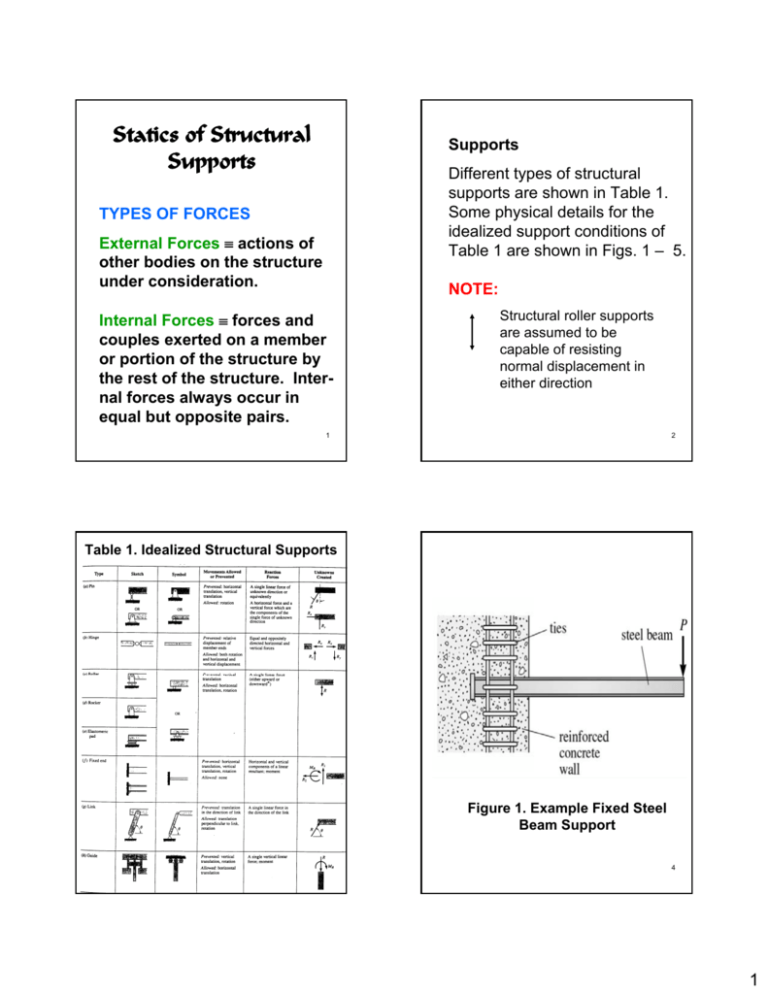
Statics of Structural Supports Supports Different types of structural supports are shown in Table 1. Some physical details for the idealized support conditions of Table 1 are shown in Figs. 1 – 5. TYPES OF FORCES External Forces ≡ actions of other bodies on the structure under consideration. NOTE: Internal Forces ≡ forces and couples exerted on a member or portion of the structure by the rest of the structure. Internal forces always occur in equal but opposite pairs. Structural roller supports are assumed to be capable of resisting normal displacement in either direction 1 2 Table 1. Idealized Structural Supports Figure 1. Example Fixed Steel Beam Support 3 4 1 Figure 2. Example Fixed Steel Column Support 5 Figure 3. Example Fixed Concrete Beam Support 6 Coped Beam Figure 4. Example Simply Supported Concrete Column Support 7 Figure 5. Example Simply Supported Floor Beam (beam 1) to 8 Girder (beam 2) Conditions 2 Equations of Static Equilibrium A structure is considered to be in equilibrium if, initially at rest, it remains at rest when subjected to a system of forces and couples. If a structure is in equilibrium, then all its members and parts are also in equilibrium. For a plane structure lying in the xy plane and subjected to a coplanar system of forces and couples, the necessary and sufficient conditions for equilibrium are: 9 Equations of condition involve known equilibrium results due to construction. ∑ Fx = 0 ∑ Fy = 0 ∑ Mz = 0 These three equations are referred to as the static equations of equilibrium of plane structures. 10 Example – Calculate the Support Reactions zero moment at hinge 11 12 3 Example – Calculate the Support Reactions RUL = 50.91 kips Influence of Reactions on Stability and Determinacy of Structures Internally Stable (rigid) ≡ structure maintains its shape and remains a rigid body when detached from the supports. Internally Unstable ≡ structure cannot maintain its shape and may undergo large displacements under small disturbances when not supported externally. 13 14 Examples of Internally Stable Structures Examples of Internally Unstable Structures 15 16 4 Statically Determinate Externally ≡ If the structure is internally stable and if all its support reactions can be determined by solving equations of equilibrium. Statically Indeterminate Externally ≡ If the structure is stable and the number of support reactions exceeds the number of available equilibrium equations. External Redundants ≡ number of reactions in excess of those necessary for equilibrium, referred to as the degree of 17 external indeterminacy. Summary – Single Rigid Structure: R < 3 Structure is statically unstable externally R = 3 Structure may be statically determinate externally R > 3 Structure is statically indeterminate externally, but may not be stable R ≡ number of support reactions 18 Summary – Several Interconnected Rigid Structures: R < 3+C Structure is statically unstable externally R = 3+C Structure may be statically determinate externally R > 3+C Structure is statically indeterminate externally, but may not be stable C ≡ number equations of conditions Ie = R - (3 + C) ≡ degree of external indeterminacy 19 Examples of Externally Statically 20 Determinate Plane Structures 5 Reaction Arrangements Causing External Geometric Instability in Plane Structures 21 Examples of Statically Indeterminate Plane Structures 22 INTERIOR HINGES IN CONSTRUCTION Example Plane Structures with 23 Equations of Condition Interior hinges (pins) are often used to join flexural members at points other than support points, e.g., connect two halves of an arch structure and in cantilever bridge construction. Such structures are more easily manufactured, transported, and erected. Furthermore, interior hinges properly placed can result in reduced bending moments in flexural systems, and such connections may result in a statically determinate structure. 24 6 Arch Structures Arch structures are usually formed to support gravity loads which tend to flatten the arch shape and thrust the supported ends outward. Hinge or fixed-end supports are generally used to provide the necessary horizontal displacement restraint. The horizontal thrust forces at the supports acting with the vertical loading tend to develop counteracting moments that result in low bending stresses. Arch Structure with Interior Hinge 25 26 Cantilever Construction Cantilever construction represents a design concept that can be used for long span structures. If spans are properly proportioned, cantilever construction can result in smaller values of the bending moments, deflections, and stresses as compared with simple support construction. Examples of Cantilever Construction 27 28 7 The following figures show a typical highway overpass structure designed as a series of simple spans (a), a statically indeterminate continuous beam (b), and a cantilevered construction beam (c) along with their respective bending moment diagrams for a uniform load of 2 kips/ft. Note that the bending moments are most evenly divided into positive and negative regions for the three-span continuous beam and that the location of the internal hinges for the cantilevered constructed bridge resulted in a more even moment distribution as compared to the overpass analyzed as three simple spans. 29 Simply Supported Spans Continuous Spans 30 Movement of the two internal hinges towards the interior supports results in a reduction of the negative moment magnitudes at the supports and an increase in the mid-span positive bending moment. Ideal placement occurs when the each interior hinge is approximately 109 ft from an end support, this location of the internal hinges results in a maximum negative and positive bending moments of 5000 ft-kips. Cantilever Construction 31 32 8 Cables Use to support bridge and roof structures; guys for derricks, radio and transmission towers; etc. Assumed to only resist loads that cause tension in the cables. Shape of cables in resisting loads is called funicular. Resultant cable force is T= H2 +V2 where H = horizontal cable force component and V = vertical cable force component. 33 Principle of Superposition ≡ on a linear elastic structure, the combined effect of several loads acting simultaneously is equal to the algebraic sum of the effects of each load acting individually. Principle is valid for structures that satisfy the following two conditions: (1) the deformation of the structure must be so small that the equations of equilibrium can be based on the undeformed geometry of the structure; and (2) the structure must be composed of linearly elastic material. 34 Structures that satisfy these two conditions are referred to as linear elastic structures. 35 9
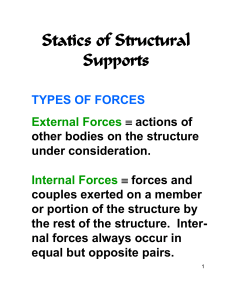
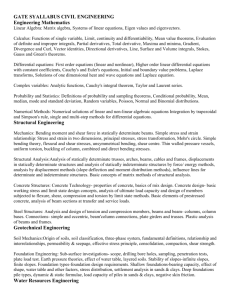
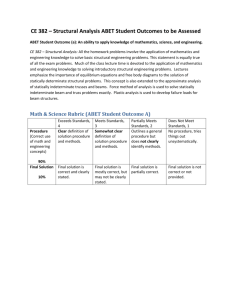

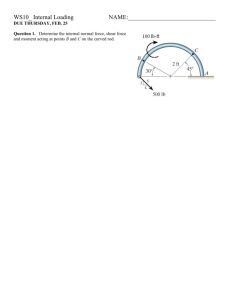
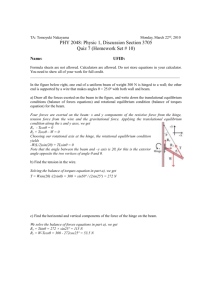
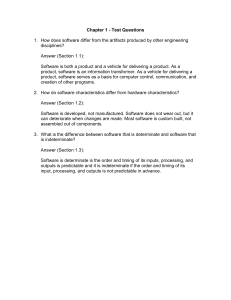
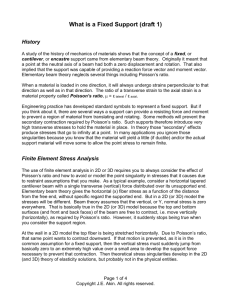
![Structural Applications [Opens in New Window]](http://s3.studylib.net/store/data/006687524_1-fbd3223409586820152883579cf5f0de-300x300.png)

